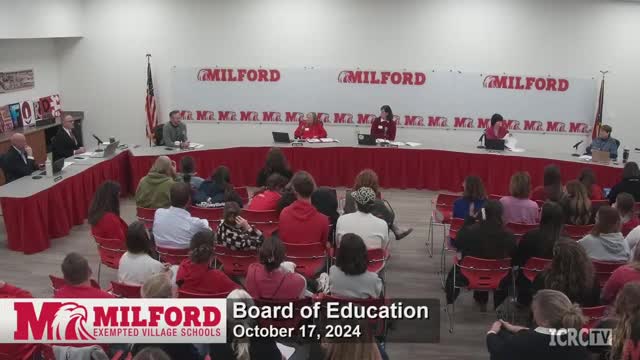Schools face drastic cuts amid funding crisis
October 18, 2024 | Milford Exempted Village, School Districts, Ohio
This article was created by AI summarizing key points discussed. AI makes mistakes, so for full details and context, please refer to the video of the full meeting. Please report any errors so we can fix them. Report an error »

In a recent government meeting, officials discussed the pressing financial challenges facing local schools, emphasizing the potential impact of proposed budget cuts and the need for new funding sources. The conversation highlighted a shift towards a \"pay-to-play\" model for sports and extracurricular activities, which could disproportionately affect students from lower-income families. This model would require families to pay for participation, raising concerns about equity in access to sports and arts programs.
The board reviewed the district's five-year financial forecast, revealing that even with significant cuts, the district remains in fiscal emergency. Officials stressed that cutting expenses alone will not resolve the financial crisis, underscoring the necessity of securing new revenue through levies or earned income taxes. The last operating increase for the district was in 2013, and officials noted that rising operational costs have made it increasingly difficult to maintain quality education and services.
The meeting also referenced the experience of nearby Little Miami schools, which faced severe budget cuts leading to a significant drop in student participation in sports and arts programs. The district's financial struggles serve as a cautionary tale, illustrating the long-term consequences of inadequate funding.
As the board prepares for a crucial levy vote on November 5, they are considering potential cuts, including reductions in transportation and extracurricular funding, should the levy fail. The board unanimously approved a motion to prepare for these cuts, reflecting the urgent need for a sustainable financial strategy to support the district's educational mission.
The board reviewed the district's five-year financial forecast, revealing that even with significant cuts, the district remains in fiscal emergency. Officials stressed that cutting expenses alone will not resolve the financial crisis, underscoring the necessity of securing new revenue through levies or earned income taxes. The last operating increase for the district was in 2013, and officials noted that rising operational costs have made it increasingly difficult to maintain quality education and services.
The meeting also referenced the experience of nearby Little Miami schools, which faced severe budget cuts leading to a significant drop in student participation in sports and arts programs. The district's financial struggles serve as a cautionary tale, illustrating the long-term consequences of inadequate funding.
As the board prepares for a crucial levy vote on November 5, they are considering potential cuts, including reductions in transportation and extracurricular funding, should the levy fail. The board unanimously approved a motion to prepare for these cuts, reflecting the urgent need for a sustainable financial strategy to support the district's educational mission.
View full meeting
This article is based on a recent meeting—watch the full video and explore the complete transcript for deeper insights into the discussion.
View full meeting
